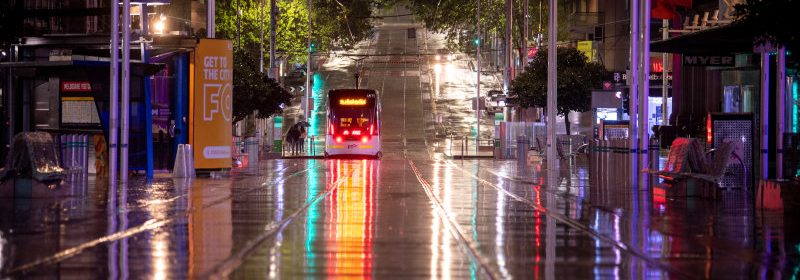Short-term pain but economists predict long-term gain for Melbourne CBD

For our free coronavirus pandemic coverage, learn more here.
Melbourne’s population will keep shrinking until late 2022 as the city continues to suffer from the after-effects of the pandemic while sectors of the economy that rely on large gatherings or international travel will struggle until 2024, according to the latest official forecast by the City of Melbourne.
But the council’s latest 20-year-forecast for jobs, population and building in central Melbourne, the first to try to model the post-COVID years, expects the city to roar back with precincts such as the Docklands and North Melbourne to almost double their populations by 2040.
Melbourne is expected to bounce back after COVID.Credit:Eddie Jim
The City of Melbourne Population and Jobs Forecasts 2020-2040, by respected consultants SGS Economics, also predicts that another 60,000 dwellings will be built to support 144,000 new residents in the local government area in the next 19 years, bringing its population to about 328,000 in 2040.
The report tips nearly 230,000 more jobs to be added to the LGA by 2040 amid a changing economic mix with retail to diminish in importance as an employment option, as shopping continues to migrate online.
Business services, health care, social assistance, education and training are predicted to be where the employment growth will be in the coming decades, representing 46 per cent of all the expected employment growth between 2020 and 2040.
The SGS analysts are also confident that the city’s dining and entertainment scenes will stage a long-term recovery, predicting the number of jobs in the food and beverage sector will double – to about 50,000 – by 2040.
But SGS also warned in its analysis of “a high degree of uncertainty when forecasting population and jobs” in the midst of a global pandemic which has now forced Melbourne into seven economically damaging lockdowns.
The analysts based their forecasts on international migration returning to pre-pandemic levels in mid- to late-2023, Melbourne’s population dip reversing in the coming years and no major long-term changes to consumer and business behaviour.
Lord mayor Sally Capp says the forecast gave the council a strong basis for planning its post-pandemic recovery.
“It shows Melbourne’s economy is on track for strong growth for the next two decades,” Cr Capp told The Age on Tuesday.
“Business owners can have confidence going forwards, knowing the hangover of the pandemic will soon be behind them.”
“It’s important we have a confident understanding of the expected level of growth to ensure we continue to deliver the right resources and services to support our city’s economic recovery.”
RMIT economics professor David Hayward said the report had followed sound methodology but the continued uncertainty around the global, local and national recovery from COVID-19 made forecasting very difficult.
“It looks like the assumption is that the city is going to return to what it was like and I think it would be terrific if that happened,” Professor Hayward said.
“But for all of us who have just lived through this pandemic there’ll be continuing concern, particularly when you’re looking 20 years into the future.
“You’d be pretty brave to back those in over that period of time, those numbers, but they’re a good outfit, SGS, they do some good work.”
The Morning Edition newsletter is our guide to the day’s most important and interesting stories, analysis and insights. Sign up here.
Most Viewed in Business
From our partners
Source: Read Full Article

